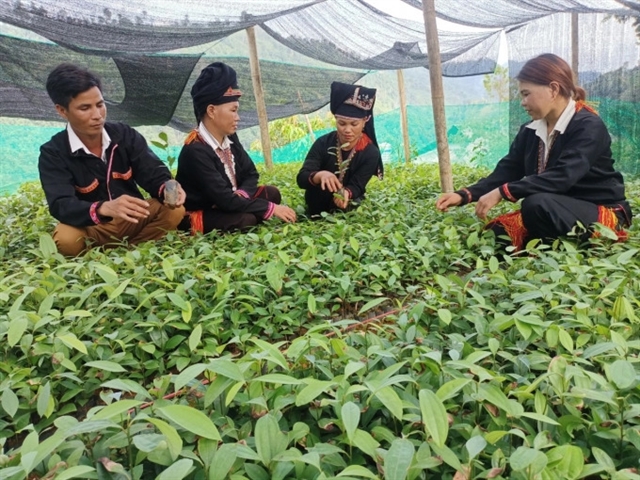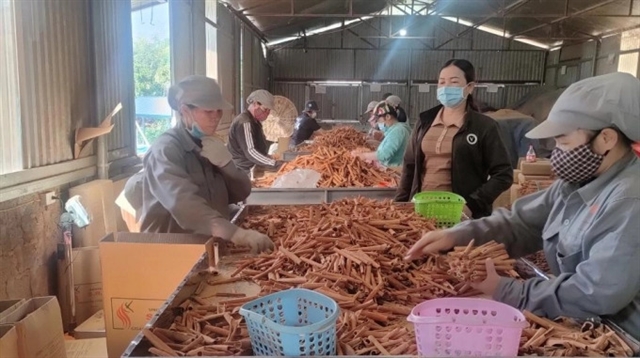 Society
Society

Thousands of women from ethnic groups in the northern province of Lào Cai have received support and gained a better understanding of cinnamon farming and the household economy.

|
| Locals share tips to better nurse cinnamon seedlings in Nậm Tha Commune, Lào Cai Province. Photo nongnghiep.vn |
LÀO CAI Thousands of women from ethnic groups in the northern province of Lào Cai have received support and gained a better understanding of cinnamon farming and household economy.
Thanks to this support, they are able to increase the value of cinnamon trees and improve their livelihoods.
Cinnamon is a key crop in Văn Bàn District in Lào Cai Province. The district has a total forest area of over 89,000ha, which is convenient for agro-forestry development.
Out of 45,000ha of cinnamon in the province, 5,460ha is in Văn Bàn District.
In the past, the planting, tending and development of cinnamon trees in the district was mainly spontaneous, using traditional techniques. Local farmers did not have the knowledge about planting areas, applying scientific advances in production and processing or connecting production and consumption. As the result, cinnamon farming generated low value.
For the last three years, the project "Developing a market system, improving the competitiveness of cinnamon products to increase economic power for women in Lào Cai Province" was implemented in two districts of Văn Bàn and Bắc Hà, bringing much higher economic values.
The project implemented by the Department of Agriculture and Rural Development, the Centre for Agricultural Extension and Agricultural Services of Lào Cai Province and the Netherlands Development Organisation (SNV) offered support for local cinnamon growers. Accordingly, more than 5,000 people, including 2,785 women in ethnic minority areas, learned more about cinnamon farming, the household economy, and work-sharing among family members.
Particularly, in Văn Bàn District, the project has made positive changes in both economic development, improving living standards and incomes for beneficiaries, as well as improving capacity, changing awareness and helping to improve their quality of life. Women, especially ethnic minority women, are now more confident in cinnamon production and business.
Vi Thị Thứ from Liêm village, Liêm Phú Commune, Văn Bàn District, said that her family and 49 others were nervous about first joining the project.
After participating in activities such as visiting models, learning, and training to improve knowledge of cinnamon planting and care, they became more confident, she said.
Previously, the division of labour in the family, as well as issues of economic development and child-rearing were not discussed, now Thứ and her husband could share and communicate with each other.
"We can break out of the customs and habits that have been ingrained in the thoughts of many men in the Tày ethnic group here, now my husband is ready to support me in housework so that I have time for social activities," Thứ said.
Under the project, effective community dialogues were carried out. Women were provided with information about economic opportunities, training courses, and approaches to businesses and cooperatives.
Thereby, more than 1,200 women have increased their confidence, changed roles and gender norms, and increased confidence to grow cinnamon trees and earn more from cinnamon trees in their homeland.
In household dialogues, husbands and wives were guided to discuss livelihoods, division of work and family planning. Discussions will be shared in community meetings at the village level and through direct interaction with local coordinators. Since then, women have been encouraged and motivated to participate in economic production activities, while men share in the housework.
Triệu Thị Phấy, a member of the cinnamon-growing group in Phường Cong village, Nậm Tha Commune, Văn Bàn District, said that for the Dao ethnic group in the commune, cinnamon cultivation was a long-standing tradition.
"Nậm Tha cinnamon is still appreciated for its quality. Thanks to the district's development plan for the key cinnamon growing area, people have focused on expanding cinnamon growing areas and applying modern techniques," she said.
"The living standards of the people in the commune have improved significantly, many households have become wealthier, with an income of VNĐ200-300 million from cinnamon cultivation, some earn up to VNĐ700-800 million per year," she said, adding that cinnamon farming created jobs for most people in the commune.
"Women in the commune take part in all the work from planting, tending, harvesting cinnamon and managing finances in the family," she said.

|
| People process cinnamon in a workshop in Văn Bàn District, Lào Cai Province. Photo nongnghiep.vn |
Hoàng Văn Hơn, Chairman of the People's Committee of Liêm Phú Commune, Văn Bàn District, said that the commune has more than 3,000 people, of which the Dao ethnic group accounts for 52 per cent, the rest are the Mông and Tày ethnic groups and the Kinh.
An organic cinnamon processing factory invested by Vietnam Cinnamon Production and Export Joint Stock Company was being built in the commune, Hơn said, adding that the presence of the factory would be a push to improve the value chain, stabilise and develop the cinnamon industry in the commune and in Lao Cai.
Hơn said that the commune established agro-forestry cooperatives, and dozens of commercial focal points are local households who directly buy, harvest, classify and preliminarily process cinnamon products of the people.
"With such facilities, cinnamon farming creates seasonal jobs with high income for many women. Moreover, they also help avoid the situation where traders from other places come to force prices and hoard people's goods," he said. VNS




